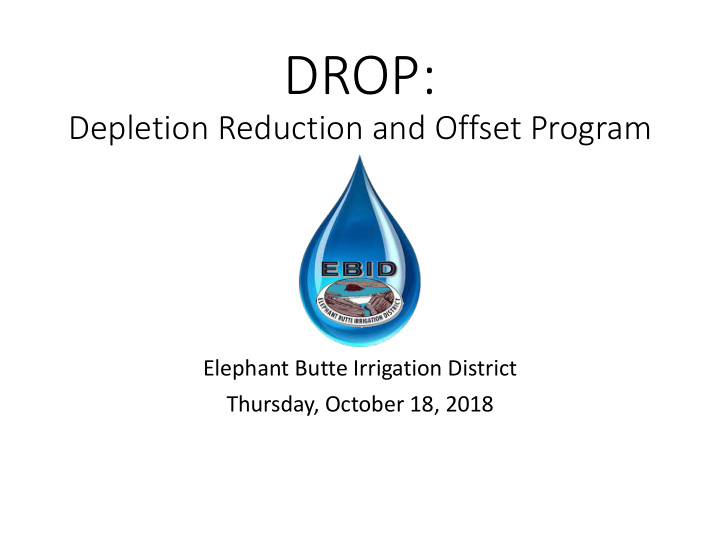



DROP: Depletion Reduction and Offset Program Elephant Butte Irrigation District Thursday, October 18, 2018
The Operating Agreement • Offsets effects of NM groundwater depletions on EP1 with surface water • Maintains EBID farmers’ access to groundwater • 1951-1978 baseline condition • Prototyped in 2006, fully implemented in 2008 • State of New Mexico didn’t like it, filed suit in federal court (NM v Reclamation, EBID, and EP1) • Texas didn’t appreciate that, filed in US Supreme Court • US intervened on behalf of Texas
Motivation for DROP • Proliferation of groundwater use in LRG • Municipal and Industrial (M&I) water users withdrawal of groundwater affects the surface water supply of the Rio Grande Project, and therefore EBID’s surface water allotment. • EBID is the only authorized user of Rio Grande Project water in New Mexico. • M&I users cannot continue or expand the use of hydrologically connected groundwater without further impairing EBID’s surface water supply. • DROP provides a market-based means for M&I users to square up with the Rio Grande Project
The core of the US Complaint: “New Mexico has allowed the diversion of surface water and pumping of groundwater that is hydrologically connected to the Rio Grande downstream of Elephant Butte Reservoir by water users who either do not have contracts with the Secretary of the Interior or are using water in excess of contractual amounts.”
DROP in a Nutshell • M&I users motivated to offset the impact of their groundwater use on the surface water supply of the Rio Grande Project enter into forbearance agreements with farmers. • Farmers are paid by the M&I user through EBID to fallow land, eliminating the local hydrologic depletion that would have occurred on that land, taken to be 2.6 acre- feet per acre of fallowed land. • M&I users continue to use their groundwater wells (or expand groundwater use), having offset their effect on the local hydrologic system and the Rio Grande Project.
Considerations • Plaintiffs in Texas v. New Mexico seek to protect the Rio Grande Project water supply from depletions by “non-Project contractors.” • DROP will allow M&I users to become Project contractors. • Direct use of surface water for M&I use is probably not practical due to the highly variable supply of surface water. • Depletion reduction directly addresses effect on interactive surface water- groundwater system and reduces stress on aquifer systems. • Excessive or poorly planned fallowing can threaten the viability of agriculture.
Percentage of total LRG groundwater withdrawals by EBID and all other LRG users
M&I Groundwater Withdrawals in the LRG
Contingencies • Entry by farmers into DROP forbearance agreements is voluntary. • Land entering program must have been irrigated four of the past five years, and must have surface water and groundwater rights. • Farmers may enroll up to 20 percent of their land into forbearance agreements, though the EBID board has the ability to waive this limit. • Lands under forbearance agreements are fallow, and not irrigated with surface water or groundwater. • Surface water allotted to land under forbearance agreement will stay with the farmer who entered into the program for use on his cultivated land or transfer to other EBID lands. • Farmers rotate land in the program through entire acreage, with a given parcel being fallowed for no more than three consecutive years. • Land in the program must be maintained according to a land management plan. • DROP will last for up to the term of the 2008 Operating Agreement.
DROP Example: 50 acre farm, 12” surface water allotment 20% = 10 acres in DROP forbearance agreement • No surface water or groundwater use on 10 acres • Depletion reduction (offset) = 2.6 ft CIR x 10 acres = 26 AF 50 acre account 40 acres in production • Surface water allotment: 12” to 50 acres (50 AF) • 15” surface water on 40 acres in production (50 AF) • 15” – 12” = 3” reduced groundwater use on 40 acres in production (10 AF)
The Bottom Line • Change of Purpose of Project Water requires compliance with the Sale of Water for Miscellaneous Purposes Act, 43 USC § 521. • Price range to be determined in that process. • Must be high enough to attract participating farmers – this is a voluntary program. • Cost borne by M&I users participating in the program.
Questions?
Recommend
More recommend